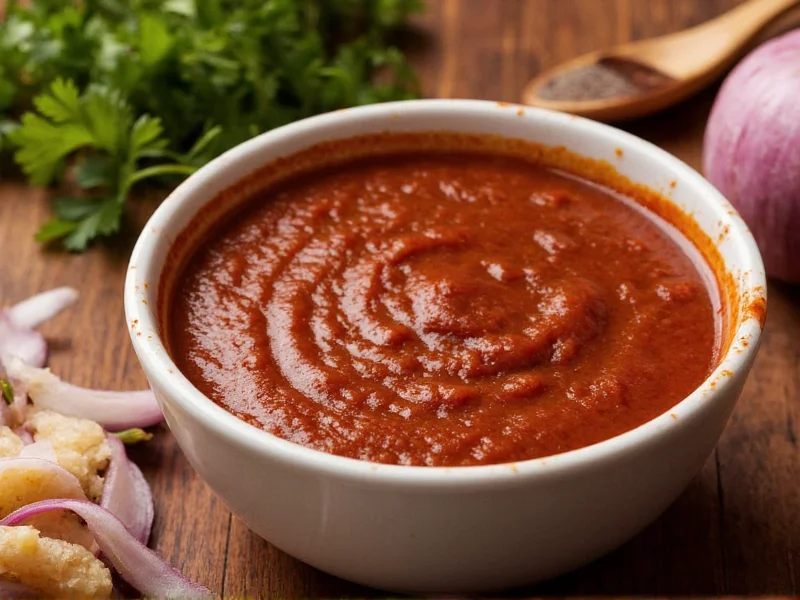Mole (pronounced moh-lay) represents one of Mexico's most celebrated culinary treasures, with roots tracing back to pre-Hispanic times. Far more than just a sauce, mole embodies centuries of cultural fusion, combining indigenous Mesoamerican ingredients with European influences introduced after colonization. Understanding its proper applications reveals why this complex sauce remains central to Mexican food culture.
Traditional Culinary Applications
At its core, mole functions as a signature sauce for poultry dishes. In central and southern Mexico, particularly in Oaxaca and Puebla, mole negro and mole poblano traditionally accompany roasted or boiled chicken. The sauce's thickness allows it to cling perfectly to meat, infusing each bite with layered flavors. Families often prepare mole for special occasions like weddings, religious celebrations, and holidays, reflecting its cultural significance beyond mere sustenance.
Authentic preparation involves simmering the sauce for hours to develop its complex flavor profile before serving it over:
- Whole or portioned chicken (most traditional application)
- Turkey (especially in Oaxacan mole negro)
- Enchiladas (mole pipián or coloradito)
- Tamales (as a filling or topping)
- Rice or potatoes (as complementary sides)
Different Mole Varieties and Their Specific Uses
Mexico recognizes seven classic moles, each with distinct ingredients and culinary purposes. Understanding these variations helps home cooks select the right mole for specific dishes:
| Mole Type | Key Ingredients | Primary Culinary Use |
|---|---|---|
| Mole Poblano | Chili peppers, chocolate, spices | Chicken dishes, enchiladas |
| Mole Negro | Multiple chilies, burnt tortillas, chocolate | Turkey, ceremonial dishes |
| Mole Coloradito | Guajillo chilies, tomatoes, spices | Pork, enchiladas |
| Mole Amarillo | Guajillo and pasilla chilies, tomatillo | Chicken, vegetables |
| Mole Verde | Tomatillo, pumpkin seeds, herbs | Chicken, fish, vegetables |
| Mole Manchamanteles | Chilies, pineapple, plantain | Pork, chicken |
| Mole Chichilo | Chilhuacle negro, avocado leaves | Beef, game meats |
Modern Interpretations and Creative Uses
Contemporary chefs have expanded traditional mole sauce applications in cooking while respecting its cultural roots. Modern interpretations include:
- Marinades - Using thinned mole as a meat tenderizer and flavor enhancer
- Soup bases - Creating rich, complex broths with mole as foundation
- Dipping sauces - Serving mole alongside empanadas or vegetable sticks
- Pizza sauces - Replacing tomato sauce with mole for fusion dishes
- Breakfast applications - Drizzling over huevos rancheros or breakfast potatoes
When adapting mole for modern kitchens, maintain respect for its traditional preparation methods while experimenting with applications that highlight its unique flavor profile. The sauce's versatility makes it suitable for both authentic Mexican dishes and creative culinary fusions.
Practical Tips for Using Mole Sauce at Home
For those exploring how to use mole sauce in cooking, consider these practical recommendations:
- Reheating properly - Gently warm mole in a saucepan with small amounts of water or broth to maintain consistency
- Adjusting thickness - Add liquid gradually until reaching desired consistency for your application
- Flavor balancing - Taste before serving and adjust with lime juice (acidity), honey (sweetness), or salt as needed
- Portion guidance - Use approximately 1 cup of mole per serving of protein
- Storage techniques - Refrigerate for up to 5 days or freeze for longer storage
Common Misconceptions About Mole Sauce
Several misunderstandings persist about traditional Mexican mole sauce uses. Clarifying these helps ensure authentic application:
- Misconception: Mole always contains chocolate
Reality: Only certain varieties (like mole poblano and mole negro) include chocolate, and even then, it's used sparingly for depth rather than sweetness - Misconception: Mole is a single standardized sauce
Reality: Each region, town, and even family has their own unique mole recipe - Misconception: Mole is extremely spicy
Reality: Authentic mole balances heat with other flavors; many varieties are mildly spiced
Pairing Mole Sauce with Complementary Elements
Understanding mole sauce pairing recommendations enhances the dining experience. Traditional accompaniments include:
- White rice - Provides neutral base that absorbs mole's complex flavors
- Warm tortillas - Essential for scooping and balancing rich sauce
- Flan or sweet plantains - Complements mole's subtle sweetness in traditional meal structure
- Refried beans - Adds protein and earthy contrast to the sauce
When serving mole, present it as the star of the plate with supporting elements that enhance rather than compete with its complex flavor profile. The sauce's versatility allows it to shine across various applications while maintaining its distinctive character.
What meats pair best with mole sauce?
Chicken and turkey represent the traditional meats paired with mole sauce, particularly in Oaxacan and Puebla regions. The sauce's complex flavor profile complements poultry exceptionally well. Some mole varieties like mole coloradito work beautifully with pork, while mole chichilo pairs well with beef or game meats.
Can mole sauce be used as a marinade?
Yes, mole sauce makes an excellent marinade when thinned with broth or water. The complex blend of chilies, spices, and nuts penetrates meat effectively, tenderizing while adding deep flavor. Allow proteins to marinate for at least 4 hours, preferably overnight, for best results.
How much mole sauce should be used per serving?
The standard serving size is approximately 1 cup (240ml) of mole sauce per portion of protein. This provides enough sauce to coat the meat thoroughly without overwhelming the dish. Adjust based on personal preference and the specific mole variety's intensity.
Does all mole contain chocolate?
No, only certain mole varieties contain chocolate. Mole poblano and mole negro traditionally include small amounts of chocolate for depth and complexity, but many regional varieties like mole verde, mole amarillo, and mole coloradito do not contain chocolate at all.
What are traditional side dishes for mole?
Traditional accompaniments include white rice, warm corn tortillas, refried beans, and sometimes sweet plantains. The rice serves as a neutral base that absorbs the sauce, while tortillas provide a vehicle for scooping. In ceremonial settings, mole might be served with specific regional sides that vary by community.











 浙公网安备
33010002000092号
浙公网安备
33010002000092号 浙B2-20120091-4
浙B2-20120091-4